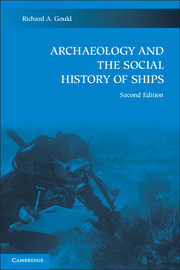Book contents
- Frontmatter
- Contents
- List of figures
- List of tables
- Acknowledgments
- Introduction: Toward a higher standard
- 1 Interpreting the underwater archaeological record
- 2 Underwater archaeology: The state of the art
- 3 Ships and shipwrecks: Basic mechanics
- 4 The archaeology of small watercraft
- 5 The earliest ships
- 6 Shipwrecks and our understanding of ancient trade
- 7 Sailing ships of the Middle Ages
- 8 Ships of the great age of sail
- 9 From sail to steam in maritime commerce
- 10 New technologies and naval warfare
- 11 The archaeology of maritime infrastructure
- 12 The future of shipwreck archaeology
- References cited
- General index
- Ship and site index
9 - From sail to steam in maritime commerce
Published online by Cambridge University Press: 05 June 2012
- Frontmatter
- Contents
- List of figures
- List of tables
- Acknowledgments
- Introduction: Toward a higher standard
- 1 Interpreting the underwater archaeological record
- 2 Underwater archaeology: The state of the art
- 3 Ships and shipwrecks: Basic mechanics
- 4 The archaeology of small watercraft
- 5 The earliest ships
- 6 Shipwrecks and our understanding of ancient trade
- 7 Sailing ships of the Middle Ages
- 8 Ships of the great age of sail
- 9 From sail to steam in maritime commerce
- 10 New technologies and naval warfare
- 11 The archaeology of maritime infrastructure
- 12 The future of shipwreck archaeology
- References cited
- General index
- Ship and site index
Summary
In contrast to the cargoes of earlier times, which consisted largely of sumptuary and priority goods, mid-19th-century maritime trade increasingly involved bulk cargoes of commodities, with steam propulsion and iron construction becoming more important as alternative technologies to sail propulsion and wood construction. The mid-to-late-19th century was an important period of transition, during which expanding economies of scale and these new technologies evolved together in a complex manner within the social context of the Western mercantile system. Underwater archaeology is proving a potent and effective tool for understanding this transition. Archaeologists studying this period cannot always expect to find preserved cargoes, even with ships known to have been used as freighters or transports. With cargoless wrecks in which all or part of the cargo (often perishable) may have been lost after the ship sank, however, analysis of the ship's structure can be as informative about the conduct of trade as it is about ship technology. Two areas discussed earlier as notorious ship traps, the Dry Tortugas and Bermuda Islands, have provided exceptional opportunities for studying maritime commerce of this period.
The Killean
Underwater surveys and documentation sponsored by the NPS in the Dry Tortugas in Florida have enabled maritime archaeologists to identify two basic categories of mid-19th-century shipwrecks there: construction wrecks, the remains of ships that were engaged in bringing building materials to Fort Jefferson between the 1840s and late 1860s, and en-route wrecks, the remains of vessels transporting cargoes through the Straits of Florida.
- Type
- Chapter
- Information
- Archaeology and the Social History of Ships , pp. 248 - 280Publisher: Cambridge University PressPrint publication year: 2011



